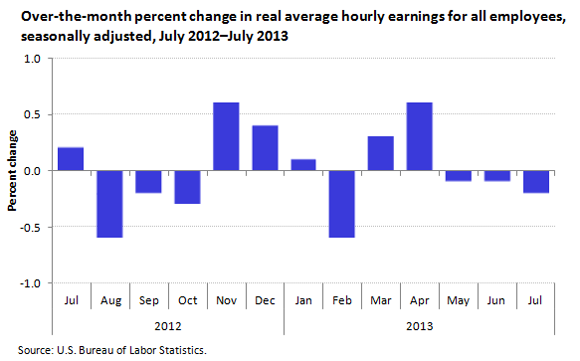An official website of the United States government
 United States Department of Labor
United States Department of Labor
Real average hourly earnings for all employees fell 0.2 percent from June to July (seasonally adjusted), the result of a 0.1-percent decrease in average hourly earnings and a 0.2-percent increase in the Consumer Price Index for All Urban Consumers (CPI-U).

| Month | Percent change |
|---|---|
Jul 2012 | 0.2 |
Aug 2012 | -0.6 |
Sep 2012 | -0.2 |
Oct 2012 | -0.3 |
Nov 2012 | 0.6 |
Dec 2012 | 0.4 |
Jan 2013 | 0.1 |
Feb 2013 | -0.6 |
Mar 2013 | 0.3 |
Apr 2013 | 0.6 |
May 2013 | -0.1 |
Jun 2013 | -0.1 |
Jul 2013 | -0.2 |
Real average weekly earnings also fell in July, as the decrease in real average hourly earnings combined with a 0.3-percent decrease in the average workweek.
Over the year (July 2012 to July 2013), real average hourly earnings decreased 0.1 percent (seasonally adjusted). Real average weekly earnings also decreased 0.1 percent during the past year, a result of the drop in real hourly earnings and no change in the average workweek over that 12-month period.
These earnings data are from the Current Employment Statistics program. Earnings data for June and July are preliminary and subject to revision. To learn more, see “Real Earnings — July 2013” (HTML) (PDF), news release USDL‑13‑1627. The Consumer Price Index for All Urban Consumers from the Consumer Price Indexes program is used to deflate the all employees data.
Bureau of Labor Statistics, U.S. Department of Labor, The Economics Daily, Real earnings fall 0.2 percent in July at https://www.bls.gov/opub/ted/2013/ted_20130819.htm (visited December 21, 2025).

